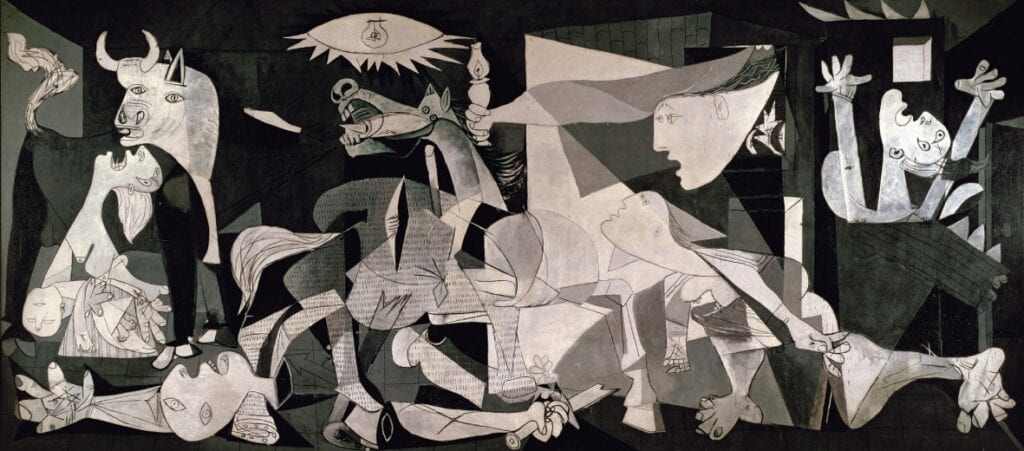A number of great artists have lived and worked in Spain. Among the most famous are El Greco, Diego Velázquez, Francisco Goya, Salvador Dalí, and Pablo Picasso, one of the most prolific artists in history and a major figure in 20th-century art.
16th Century: El Greco (1541-1614)
It was during the reign of Philip II that the first great genius of Spanish painting, El Greco, settled in the country. He was born in Crete and worked in Italy before moving to Toledo in about 1577. His highly emotional style gave powerful expression to the religious fervour of his adopted country but it was not to Philip’s taste. El Greco consequently enjoyed little royal patronage but he produced a succession of magnificent altarpieces for churches in Toledo.

In 1586 El Greco painted one of his greatest masterpieces, The Burial of Count Orgaz, for the Church of Santo Tomé in Toledo. This work, still in place, portrays a 14th-century Toledan nobleman laid in his grave (in actuality situated just below the painting) by St Stephen and St Augustine. Above, the count’s soul rises to a heaven densely populated with angels, saints, and contemporary political figures.
17th Century: Diego Velázquez (1599-1660)
The artist probably most loved by the Spanish people is Velázquez who painted religious pictures and also occasional mythological scenes and tavern scenes with a prominent still-life element. He worked primarily as a portraitist and in this field he was acknowledged as one of the greatest artists the world has ever known.

His masterpiece, Las Meninas (The Maids of Honour, 1656, Prado), is a stunning group portrait of the royal family and Velázquez himself in the act of painting.
18th Century: Francisco Goya (1746-1828)
The greatest painter of his time in Spain and also probably the most powerful and original figure in the visual arts in the whole of Europe was Francisco Goya. In his time he was best known as a portraitist but he is now equally renowned for other types of work including the powerful engravings that he made showing the atrocities of the French occupation of Spain during the Napoleonic Wars.

19th Century: Joaquin Sorolla (1863-1923)
Goya was an isolated genius and after him there were no painters of European standing in 19th-century Spanish art although there were some charming minor masters, such as Joaquin Sorolla, whose work—influenced by Impressionism—is characterized by brilliant colour and vigorous brushwork. His distinct ability to depict the effects of light comes across strongly in many of his beach scenes of his native Valencia.

20th Century: Pablo Picasso (1881-1973)
One of the most prolific artists in history was Pablo Picasso who spent most of his life in France but his work often used imagery from his native country. The bullfight was a favourite subject and his most famous painting, Guernica (1937, Centro Cultural de la Reina Sofia, Madrid), was inspired by his revulsion at the bombing of the Basque town during the Spanish Civil War.

Joan Miró (1893-1983)
Of the modern Spanish painters who remained in Spain the most illustrious was Joan Miró. He spent a good deal of time in Paris but lived mainly in and around his native Barcelona and later on the island of Mallorca. An immensely prolific and versatile artist he created a distinctive and witty style blending Surrealism and abstraction.

Salvador Dalí (1904-1989)
A flamboyant painter and sometime writer, sculptor and experimental film-maker, Salvador Dali was probably the greatest Surrealist artist using bizarre dream imagery to create unforgettable and unmistakable landscapes of his inner world. His most famous work is The Persistence Of Memory. The Dalí Museum in Figueres is one of the top attractions in Catalonia.


I have 4 beautiful paintings which I obtained in Spain in the 1950’s. They are about 5 X 7 inches, two of bulls and men on horseback; and two of men with women in colorful full frilly skirts. The small paintings are signed “Iglesias, Sevilla.” I can email photos of them if you’d like. What can you tell me about the artist, and maybe about the current value of the paintings ? Thank you !
Hi Joe
I’m afraid it’s impossible for us to identify or value such paintings. ‘Iglesias’ is a very common name in Spain and I’m sure that many artists with this surname have created works which portray bullfighting and flamenco in the Seville region over the years. If you believe them to be of value you’d need to contact an art specialist.
Good Luck
Gerry
We purchased paintings in Spain during the 1980’s. The name on the paintings are Torquamada. She was a young lady that displayed her paintings along the steps of Malaga and then later she had a store downtown. I am wondering if she stiil paints?
my father met a young man jose suarez gomez in madrid about 1967. we were stationed at Torrejon Air Base and we lived in the area in english called royal oaks. en el cenar de los reyes. who painted two beautiful paintings the first one was an elk on a hill from an illustration of a wildlife book.and the second one was a big horn sheep in a desert mountain area. My father showed him the book and told him if he would paint two paintings from the illustrations he would give him a good reward for this work. recently my father passed and we still have the paintings. do think they have much value? the paintings are signed suarez gomez. they are both custom painted from american painter’s illustrations. do these paintings have much value?i hear that Mr. Suarez Gomez is still alive and painting in his 80’s. i would like to know more about him. i cant seem to find any websites that feature or mention him. no facebook or twitter etc.
Sorry Bob but I can’t help with this request … perhaps if I post it there will be someone out there who might have some useful information.